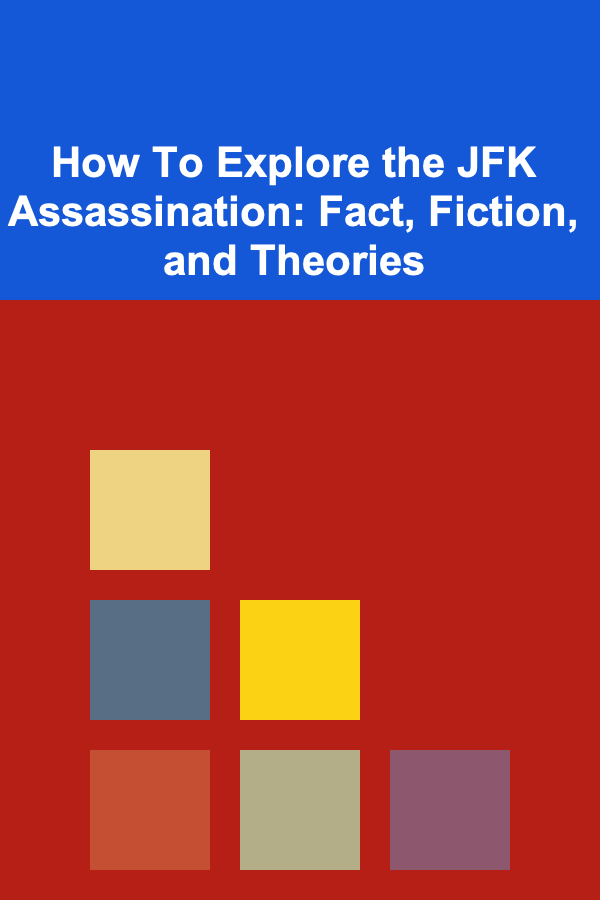
How To Explore the JFK Assassination: Fact, Fiction, and Theories
ebook include PDF & Audio bundle (Micro Guide)
$12.99$6.99
Limited Time Offer! Order within the next:

The assassination of President John F. Kennedy on November 22, 1963, in Dallas, Texas, is one of the most discussed and debated events in modern history. The tragic death of Kennedy, at the height of his presidency, left an indelible mark on the American psyche and sparked numerous investigations, discussions, and conspiracy theories that continue to captivate people even decades later. The fact, fiction, and theories surrounding the assassination of JFK have become intertwined, creating a complex narrative that combines historical events, speculation, and the search for truth.
In this article, we will explore how to approach the JFK assassination, examining the established facts, the myths and misconceptions, and the various conspiracy theories that have emerged over the years. This exploration not only sheds light on the assassination itself but also reflects the broader cultural and political landscape of the 1960s, the evolution of public trust in government institutions, and the enduring quest for truth in the face of unresolved mysteries.
The Facts: What We Know for Sure
1. The Event Itself
On November 22, 1963, President John F. Kennedy was shot while riding in a motorcade through Dealey Plaza in Dallas, Texas. Kennedy, accompanied by his wife Jacqueline, Texas Governor John Connally, and Connally's wife Nellie, was in a 1961 Lincoln Continental convertible. As the motorcade passed the Texas School Book Depository, three shots were fired from a sixth-floor window, striking Kennedy and Governor Connally.
Kennedy was struck by two bullets, one in the upper back and one in the head. The fatal shot, which struck him in the head, was the one that ultimately led to his death. Kennedy was rushed to Parkland Memorial Hospital, where he was pronounced dead at 1:00 PM, just 30 minutes after the shooting. Vice President Lyndon B. Johnson, who was in the motorcade but was not hit, was immediately taken to a secure location, where he was later sworn in as the 36th President of the United States aboard Air Force One at Dallas Love Field Airport.
2. Lee Harvey Oswald: The Official Assassin
The man arrested for the assassination was Lee Harvey Oswald, a 24-year-old former U.S. Marine who had defected to the Soviet Union in 1959 before returning to the U.S. in 1962. Oswald was captured in a nearby movie theater shortly after the assassination and was charged with the murder of Kennedy. On November 24, 1963, while being transferred from the city jail to the county jail, Oswald was shot and killed by nightclub owner Jack Ruby, an event that only added to the mystery surrounding Kennedy's death.
3. The Warren Commission Report
In the aftermath of the assassination, President Johnson established the Warren Commission, headed by Chief Justice Earl Warren, to investigate the circumstances of Kennedy's death. The commission concluded in its final report in 1964 that Lee Harvey Oswald acted alone in the assassination. According to the Warren Commission, Oswald fired three shots from the sixth-floor window of the Texas School Book Depository, with two of them striking Kennedy and Governor Connally.
The Warren Commission's findings were based on a range of evidence, including eyewitness testimony, ballistics analysis, and forensic investigation. It concluded that there was no evidence of a conspiracy, and Oswald's motive appeared to be his personal disillusionment with the American government, which had led him to defect to the Soviet Union years earlier.
However, despite the official conclusions of the Warren Commission, many people were skeptical of its findings, and the investigation itself has been the subject of significant criticism over the years. The controversy surrounding the assassination has only deepened as more information has become available, leading to a flood of alternate theories and interpretations.
The Fiction: Myths and Misconceptions
1. The "Single Bullet Theory"
One of the most controversial aspects of the Warren Commission's report is the "single bullet theory," which suggests that one bullet fired by Oswald struck both President Kennedy and Governor Connally. According to the theory, the bullet passed through Kennedy's neck, then struck Connally in the back, chest, wrist, and thigh.
This theory has been widely criticized because it seems implausible that a single bullet could cause such a complex pattern of injuries. Skeptics argue that the trajectory of the bullet, the severity of the wounds, and the lack of a clear explanation for how the bullet could have caused all of these injuries make the single bullet theory highly questionable. This has fueled ongoing debates and has led some to believe that the true sequence of events was not fully disclosed by the Warren Commission.
2. The "Magic Bullet"
The "magic bullet" theory is an extension of the single bullet theory, and it has become a central point of contention for those who challenge the official account of the assassination. The term "magic bullet" was coined by critics who found it hard to believe that a single bullet could have caused such a diverse range of injuries. Many believe that the bullet's improbable trajectory is simply too extraordinary to be believable, and some argue that it points to a larger conspiracy involving multiple shooters.
The debates surrounding the "magic bullet" theory continue to this day, with many analysts and historians questioning the official account of the assassination. Some have suggested that the bullet's path was altered by a second gunman or that the evidence was manipulated to support the conclusion that Oswald acted alone.
3. The Zapruder Film
The Zapruder film is a famous 26-second home movie filmed by Abraham Zapruder, a bystander who was watching the motorcade pass through Dealey Plaza. The film captures the moment when Kennedy was shot and offers some of the most crucial visual evidence in the case. In the years following the assassination, various theories and interpretations have been based on the Zapruder film, particularly regarding the angle of the fatal shot and the number of gunmen involved.
Some have argued that the film shows evidence of a second gunman, with the timing of the shots and the movement of Kennedy's head suggesting that he was struck from more than one direction. Others contend that the film supports the official version of events, despite the uncertainty surrounding certain details. The Zapruder film remains a pivotal piece of evidence, but it has also been subject to manipulation and selective interpretation by those who seek to support their own theories.
The Theories: Who Was Behind the Assassination?
1. The Lone Gunman Theory
The official story, as laid out by the Warren Commission, is that Lee Harvey Oswald acted alone in assassinating President Kennedy. According to this theory, Oswald was a deeply disillusioned individual who sought to make a statement by killing the president. The lone gunman theory, however, has been widely challenged by conspiracy theorists who argue that there were other people involved in the assassination.
2. The Mafia Conspiracy
One of the most prominent conspiracy theories suggests that the Mafia played a role in Kennedy's assassination. According to this theory, the Mafia had a motive to kill Kennedy due to his administration's crackdown on organized crime, particularly through his brother, Attorney General Robert Kennedy's aggressive pursuit of Mafia figures.
Some theorists believe that the Mafia may have been involved in orchestrating the assassination as a way to retaliate against the Kennedys' efforts to dismantle their criminal organizations. This theory is based on the notion that Oswald's apparent connections to organized crime could be evidence of a larger conspiracy.
3. The CIA and the Cuban Connection
Another widely discussed theory posits that the Central Intelligence Agency (CIA) was involved in the assassination, possibly in connection with the Cuban exile community. This theory suggests that the CIA was unhappy with Kennedy's handling of the Cuban Missile Crisis and the failed Bay of Pigs invasion, and they may have seen Kennedy as weak or ineffective in dealing with Cuba.
Some believe that the CIA may have sought to eliminate Kennedy as a way of regaining control over U.S. policy toward Cuba. This theory is supported by allegations that Oswald had ties to pro-Castro groups and that the CIA may have been monitoring him before the assassination. The Cuban connection is often cited as a key piece of evidence in the CIA conspiracy theory.
4. The Second Gunman Theory
The theory of a second gunman suggests that Oswald did not act alone and that a second shooter was present, possibly on the grassy knoll in Dealey Plaza. This theory has been fueled by eyewitness accounts, the Zapruder film, and the idea that the fatal headshot came from a different angle than what would have been possible from Oswald's position in the Texas School Book Depository.
Supporters of the second gunman theory argue that the "magic bullet" theory is flawed and that there must have been at least one other person involved in the shooting. This theory continues to be a subject of intense debate among researchers and remains one of the most enduring aspects of the JFK assassination mystery.
Conclusion: The Enduring Mystery
The assassination of John F. Kennedy remains one of the most compelling and controversial events in modern history. Despite the official conclusion that Lee Harvey Oswald acted alone, the numerous conspiracy theories surrounding the event continue to intrigue and perplex both scholars and the public. The quest for truth in the case of JFK's assassination has not only shaped our understanding of that pivotal moment in American history but also fueled broader questions about the role of government, the media, and the public in shaping historical narratives.
As we explore the JFK assassination, it becomes clear that the line between fact and fiction is often blurred, and the search for answers is shaped by a variety of perspectives and interpretations. Whether you believe in the official story or one of the many conspiracy theories, the assassination of JFK remains a defining moment in history that continues to provoke discussion, analysis, and debate.
In the end, perhaps the greatest lesson we can learn from the JFK assassination is the importance of critical thinking, skepticism, and an unwavering pursuit of truth in the face of uncertainty. The enduring mystery of Kennedy's death serves as a reminder that history is often more complex and nuanced than we may initially believe, and the search for answers is a journey that continues to captivate us.

How to Create an Efficient Pet Supply Storage System
Read More
How to Manage Seasonal Demand for Your Home Rental Property
Read More
How to Use Bins and Containers to Store Hobby Supplies
Read More
How to Optimize Your Brain for Emotional Well-Being
Read More
How to Find Exciting Wildlife Encounters
Read MoreImplementing Blockchain for Art Provenance Tracking: A Comprehensive Guide
Read MoreOther Products

How to Create an Efficient Pet Supply Storage System
Read More
How to Manage Seasonal Demand for Your Home Rental Property
Read More
How to Use Bins and Containers to Store Hobby Supplies
Read More
How to Optimize Your Brain for Emotional Well-Being
Read More